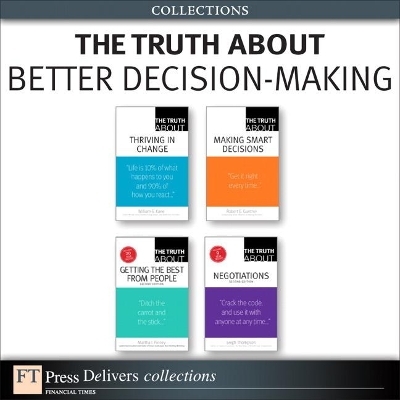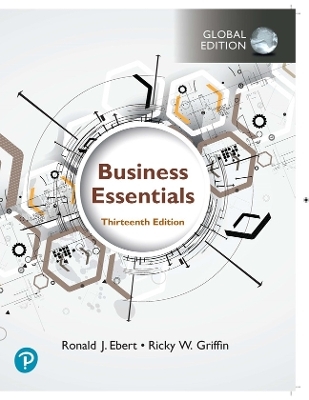
The Truth About Better Decision-Making (Collection)
Addison Wesley
978-0-13-344574-9 (ISBN)
4 authoritative books bring together hundreds of bite-size, easy-to-use techniques for optimizing every business decision, choice, interaction, and negotiation!
Your decisions drive your business performance and determine your career success. Whether you’re collaborating, leading, negotiating, or persuading, those decisions must be consistently sharp – and this 4 book collection will help you sharpen every decision you make. Start with Robert Gunther’s The Truth About Making Smart Decisions: 50 powerful bite-size “truths” about making better real-world decisions when it matters most. Gunther shows how to systematically prepare to make better decisions... get the right information, without getting buried in useless data... minimize risks and then act decisively... handle emotions... make better group decisions... profit from mistakes... and much more. Next, William S. Kane focuses on the decision to change – and to lead change. In The Truth About Thriving in Change, Kane shares 49 powerful decision-making “truths” about change leadership: which skills you need most, and how to develop them... how to lead change without eroding commitment or productivity... why you must start fast, and “run before you walk”... when to persuade, when to educate, and when to “use force”... how to create the right cultural framework for successful change, and more. Next, Leigh Thompson’s The Truth About Negotiations helps you optimize every decision associated with successful negotiations. Thompson provides realistic game plans that work in any scenario, showing how to create win-win deals by leveraging carefully collected information. Learn how to prepare quickly and efficiently… handle imperfect negotiating situations… establish trust with someone you don’t yet trust… recognize when to walk away. Thompson guides through planning strategy, identifying your “best alternative to a negotiated agreement,” making the right first offer to control the process, resolving difficult disputes, and achieving the goals that matter most. Finally, in The Truth About Getting the Best From People, Second Edition, Martha Finney turns to day-to-day management decision-making, offering 60+ powerful techniques -- including new ways to persuade, manage virtual teams, overcome unconscious decision-making biases, and identify/cultivate high performers. These four books offer definitive, evidence-based principles for optimizing your decision-making throughout your entire management career!
From world-renowned decision-making experts Robert E. Gunther, William S. Kane, Leigh Thompson, and Martha I. Finney
Robert E. Gunther, founder of Gunther Communications, is co-author or collaborator on more than 20 books. He has appeared on CNBC’s Power Lunch, NPR’s Morning Edition, and numerous local and national radio and television programs. William S. Kane is a highly accomplished HR executive with experience in all aspects of global functional management. He has specific expertise in leading, planning, and executing human capital strategies associated with several profitable business transformations. Kane has held senior positions at global leaders such as International Flavors and Fragrances Inc., Electrolux/Frigidaire, and FMC Corporation. He is now VP of human resources and general administration for Kyowa Pharmaceutical, and adjunct professor in the MAOB graduate-level certificate program in leadership studies at Fairleigh Dickinson University. Leigh L. Thompson is J. Jay Gerber Distinguished Professor of Dispute Resolution and Organizations in the Kellogg School of Management at Northwestern University. An active consultant and internationally recognized scholar, she also directs Kellogg’s AT&T Behavioral Research Laboratory and Leading High Impact Teams Executive Program. Martha I. Finney is a writer and consultant who brings the qualitative perspective of workplace passion and problem-solving to clients who value the transformative power of engaged employees. She is author or co-author of more than 13 books, including HR From the Heart: Inspiring Stories and Strategies for Building the People Side of Great Business, with Libby Sartain.
The Truth About Making Smart Decisions
Preface ix
Introduction x
Part I The Truth About Preparing for Decisions
Truth 1 Before a major decision, get some Z’s 1
Truth 2 Act from a state of clarity 3
Truth 3 If you can’t get distance, get perspective 7
Truth 4 Keep it real 11
Truth5 Use a systematic process 15
Truth 6 Know your decision-making style 19
Part II The Truth About Why Bad Decisions Are Good
Truth 7 To make better decisions, make more mistakes 23
Truth 8 Be prepared to profit from your mistakes 27
Truth 9 Learn from your close calls 29
Truth 10 Learn from the decisions of others 33
Truth 11 Don’t judge your decisions based on their outcome 35
Truth 12 Leave yourself room to get back from the pole 39
Part III The Truth About the Limits of Your Mind
Truth 13 Understand common “decision traps” 43
Truth 14 Giving up something? Get over it! 47
Truth 15 It’s possible to miss an entire gorilla 51
Truth 16 You may see only what you’re looking for 53
Truth 17 You’re not as clever as you think you are 57
Truth 18 Your view of the world depends on what planet you’re from 61
Truth 19 Beware of seeing patterns that aren’t there 65
Truth 20 Different is not always better 69
Part IV The Truth About Complex Decisions
Truth 21 Boil knowledge down to its essence–and then act on it 71
Truth 22 Decisions are not snapshots but movies 75
Truth 23 No decision is an island 79
Truth 24 Build the city around your decision 83
Part V The Truth About Data
Truth 25 Listen for the dog that doesn’t bark 85
Truth 26 Sorry, Joe Friday. The facts are never “just the facts.” 89
Truth 27 Recognize the power of intuition 91
Part VI The Truth About Acting Decisively
Truth 28 The wrong decision is better than none at all 95
Truth 29 Get 80 percent (or less) of what you need, and then act on it 99
Truth 30 Every decision carries risk. Get used to it. 103
Truth 31 Not making a decision is a decision 107
Part VII The Truth About Decisions in Groups
Truth 32 Two heads can be worse than one 111
Truth 33 Use constructive conflict 115
Truth 34 Surround yourself with people smarter than yourself 119
Truth 35 Make decision roles clear 123
Truth 36 Break free from the prisoner’s dilemma 127
Part VIII The Truth About Emotions
Truth 37 A little adrenaline can be a good thing 131
Truth 38 Understand the impact of emotions 135
Truth 39 Beware of the attractive new shortcut 139
Part IX The Truth About Ethical Decision Making
Truth 40 Don’t do anything you wouldn’t want seen on YouTube 143
Truth 41 There are no quiet corners safe from scrutiny 145
Truth 42 To know where you’re going, know where you stand 149
Truth 43 Don’t let power or ego sway you from your course 153
Part X The Truth About Big Decisions
Truth 44 Lower the costs of failure 157
Truth 45 Break down big decisions into smaller ones 161
Truth 46 Don’t forget the screwdrivers 165
Part XI The Truth About Moving On
Truth 47 Keep your eye on the long term 169
Truth 48 Belief in your decision can make it come true 173
Truth 49 Keep a sense of humor 177
Truth 50 Don’t look back 181
Additional Resources 183
References 184
About the Author 188
The Truth About Thriving in Change
Preface ix
Part I The Truth About Staying or Going
Truth 1 Life is 10% of what happens to you and 90% of how you react 1
Truth 2 If your values don’t agree, it’s probably time to flee 5
Truth 3 Service awards aren’t what they used to be 9
Truth 4 Teaching long division doesn’t work on a Blackberry 13
Part II The Truth About What You should Pack
Truth 5 It’s not what you’ve got; it’s what you need 17
Truth 6 To manage change, you must lead change 21
Truth 7 You can’t do without a “can-do” attitude 25
Truth 8 If you don’t stand for something, you’ll fall for anything 29
Part III The Truth About those Early Days
Truth 9 Run before you walk 33
Truth 10 Keep your boss your biggest fan 37
Truth 11 There are only three ways to introduce change 41
Truth 12 Build the case: It’s a challenge and an opportunity 45
Truth 13 Teach others how to treat you 49
Part IV The Truth About Planning
Truth 14 If you don’t know where you’re going, you’ll get there 53
Truth 15 To realize the future, you must create it 57
Truth 16 Convert aspiration to invitation 61
Truth 17 Having organizational values matters; living then means more 65
Truth 18 Make the change agenda everyone’s agenda 69
Part V The Truth About Communications
Truth 19 We listen with our eyes 73
Truth 20 Email is the tool of the devil 77
Truth 21 People can’t drink from a fire hose 81
Truth 22 Conversion is for missionaries and crusaders 85
Part VI The Truth About Matching People with Purpose
Truth 23 Organizational structure: Look in from the outside 89
Truth 24 Build your team around your “A” players 93
Truth 25 Candidate screening: Let the facts speak for themselves 97
Truth 26 Avoid the ten potential “placement pitfalls” 101
Truth 27 Don't surround yourself with yourself 105
Truth 28 Why you need to get staffing right 109
Truth 29 If you must “right-size,” do it the right way 113
Part VII The Truth About Managing Performance
Truth 30 One style doesn’t fit all 117
Truth 31 You can influence without authority 121
Truth 32 You can’t work the plan if you don’t plan the work 125
Truth 33 There’s no excuse for excuses 129
Truth 34 Know what buttons to push 133
Part VIII The Truth About Creating your Cultural Framework
Truth 35 Calm waters make for easier sailing 137
Truth 36 Trust is a currency not easily earned, but easily spent 141
Truth 37 If you’re out of sight, you’re probably out of touch 145
Truth 38 Teams aren’t a necessary evil 149
Truth 39 Your way may not be the best way 153
Truth 40 The whole is greater than the sum of the parts 157
Truth 41 Embrace[md]don’t run from[md]the questions! 161
Truth 42 Decision making: The fastest don’t always finish first 165
Truth 43 Exceptions: Can’t live with them; can’t live without them 169
Truth 44 Employee discipline: Ask the more meaningful question 173
Part IX The Truth About Recognition and Reward
Truth 45 Make every employee feel like your only employee 177
Truth 46 A little formal recognition goes a long way 181
Part X The Truth About Sustenance
Truth 47 Your best investment is in… YOU 185
Truth 48 Your title is manager; your job is teacher 189
Truth 49 Trying to be all things to all people is a slippery slope 193
References 197
About the Author 211
The Truth About Negotiations, Second Edition
Introduction vii
Part 1: Negotiation: A 30,000-foot view 1
Truth 1: Negotiation: A natural gift? 3
Truth 2: The magic bullet: Preparation 7
Truth 3: Your industry is unique (and other myths) 11
Truth 4: Win–win, win–lose, and lose–lose negotiations 15
Truth 5: Four sand traps in the golf game of negotiation 19
Truth 6: If you have only one hour to prepare 23
Part 2: The bottom line on bottom lines 27
Truth 7: Identify your BATNA 29
Truth 8: Develop your reservation price 33
Truth 9: It’s alive! Constantly improve your BATNA 37
Truth 10: Don’t reveal your BATNA 41
Truth 11: Don’t lie about your BATNA 45
Truth 12: Signal your BATNA 49
Truth 13: Research the other party’s BATNA 53
Part 3: Black belt negotiation skills 55
Truth 14: Set optimistic but realistic aspirations 57
Truth 15: The power of making the first offer 61
Truth 16: What if the other party makes the first offer? 65
Truth 17: Plan your concessions 69
Truth 18: Be aware of the “even-split” ploy 73
Truth 19: Reveal your interests 77
Truth 20: Negotiate issues simultaneously, not sequentially 81
Truth 21: Logrolling (I scratch your back, you scratch mine) 85
Truth 22: Make multiple offers of equivalent value simultaneously 89
Truth 23: Postsettlement settlements 93
Truth 24: Contingent agreements 97
Part 4: Psychology 101
Truth 25: The reciprocity principle 103
Truth 26: The reinforcement principle 107
Truth 27: The similarity principle 111
Truth 28: The anchoring principle 115
Truth 29: The framing principle 119
Part 5: People problems (and solutions) 123
Truth 30: Responding to temper tantrums 125
Truth 31: How to negotiate with someone you hate 129
Truth 32: How to negotiate with someone you love 133
Truth 33: Of men, women, and pie-slicing 137
Truth 34: Your reputation 141
Truth 35: Building trust 145
Truth 36: Repairing broken trust 149
Truth 37: Saving face 153
Part 6: I-negotiations and E-negotiations 157
Truth 38: Negotiating on the phone 159
Truth 39: Negotiating via email and the Internet 163
Truth 40: When negotiations shift from relational to highly transactional 167
Truth 41: Negotiating across generations 171
Truth 42: Negotiating with different organizational cultures 175
Truth 43: Negotiating with different demographic cultures 179
Part 7: Negotiation Yoga 183
Truth 44: What’s your sign? (Know your disputing style) 185
Truth 45: Satisficing versus optimizing 189
Truth 46: Are you an enlightened negotiator? 193
References 197
Acknowledgments 203
About the Author 204
The Truth About Getting the Best from People, Second Edition
Introduction xi
PART I The Truth About Employee Engagement
Truth 1 You don’t need the carrot or the stick 1
Truth 2 You have direct influence over your employees’ passion quotient 4
Truth 3 You get the best by giving the best 8
Truth 4 It’s not money that motivates 11
Truth 5 Employment engagement isn’t for sissies 15
Truth 6 Real engagement gains happen after survey scores come in 19
PART II The Truth About Yourself
Truth 7 Your behaviors are your brand 23
Truth 8 You can’t give what you don’t have 26
Truth 9 “Best” doesn’t mean the same thing to everyone 30
Truth 10 Think you’re a great leader? Think again 34
Truth 11 You could be your own worst employee 38
Truth 12 Visionary or beat cop? Your choice 41
Truth 13 Your health may be compromising your leadership effectiveness 44
Truth 14 You don’t have to be perfect 48
Truth 15 Your career can recover from an engagement hit 52
PART III The Truth About Engaged Cultures
Truth 16 Employee happiness is serious business 55
Truth 17 Great leaders make their people cry 58
Truth 18 Better questions lead to better answers 61
Truth 19 Individual passion builds a passion-fueled customer service culture 65
Truth 20 Authentic is better than clever 69
Truth 21 Retention begins with hello 72
Truth 22 The bad will do you good 75
Truth 23 Your biggest complainer may be your best supporter 78
Truth 24 You can sell an unpopular decision 82
Truth 25 Flex is best 85
Truth 26 Nobody cares if you don’t mean to be mean 89
Truth 27 Controlling your temper is a labor-saving device 93
Truth 28 There is no “but” in “I’m sorry” 97
PART IV The Truth About Motivation
Truth 29 Engagement happens one person at a time 101
Truth 30 If you’re a manager, you’re a career coach 104
Truth 31 The candidates you’re seeking may not be the ones you need 107
Truth 32 Ask for cheese—you might get the moon 111
Truth 33 You lead better when you get off your pedestal 114
Truth 34 Trust is your strongest persuasion tool 118
Truth 35 If they aren’t buying it, they aren’t doing it 121
Truth 36 Overselling an opportunity can cost you precious talent 124
Truth 37 Focusing on what’s right can help solve what’s wrong 128
Truth 38 High performers are motivated by a piece of the action 131
Truth 39 All the generations want the same thing 135
PART V The Truth About Performance
Truth 40 Compassion promotes performance 139
Truth 41 A hot star can brighten your whole team 142
Truth 42 B players are your A team 146
Truth 43 High performers have enough coffee mugs 149
Truth 44 Discipline deepens engagement 152
Truth 45 You don’t have to inherit the problem employees 155
Truth 46 Performance appraisals are really about you 159
Truth 47 New hires can inspire current employees 162
Truth 48 Terminations are an engagement tool 165
PART VI The Truth About Creativity
Truth 49 Innovation begins with y-e-s 169
Truth 50 Everyone can be creative 172
Truth 51 You stand between inspiration and implementation 176
Truth 52 Failures promote progress 179
Truth 53 People don’t quit their bosses, they quit their colleagues 182
Truth 54 Extreme pressure kills inspired performance 186
Truth 55 Creativity is a balancing act 189
PART VII The Truth About Communication
Truth 56 Open questions ignite inspiring answers 193
Truth 57 Serving your employees means managing your boss 196
Truth 58 Bad news is good news 200
Truth 59 Trivial conversations are essential 203
Truth 60 The way you listen speaks volumes 206
Truth 61 Crap happens 210
Truth 62 Engaged employees need to know more 213
PART VIII The Truth About Teams
Truth 63 Absence makes the employee happier 217
Truth 64 Your team has untapped talent 221
Truth 65 People need to fight their own battles 224
Truth 66 Games don’t build teams 228
Truth 67 Answers build teams 231
Truth 68 Your team can lead you to greatness 234
Truth 69 You’re still the boss 237
References 240
About the Author 242
| Erscheint lt. Verlag | 4.7.2014 |
|---|---|
| Reihe/Serie | Truth About |
| Verlagsort | Boston |
| Sprache | englisch |
| Gewicht | 1 g |
| Themenwelt | Wirtschaft ► Betriebswirtschaft / Management |
| Wirtschaft ► Volkswirtschaftslehre | |
| ISBN-10 | 0-13-344574-7 / 0133445747 |
| ISBN-13 | 978-0-13-344574-9 / 9780133445749 |
| Zustand | Neuware |
| Haben Sie eine Frage zum Produkt? |
aus dem Bereich


